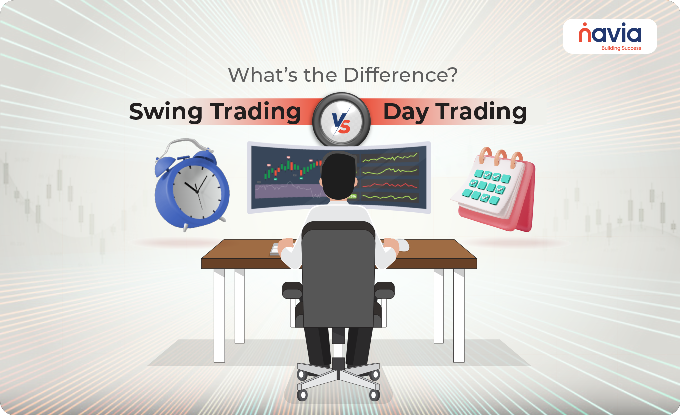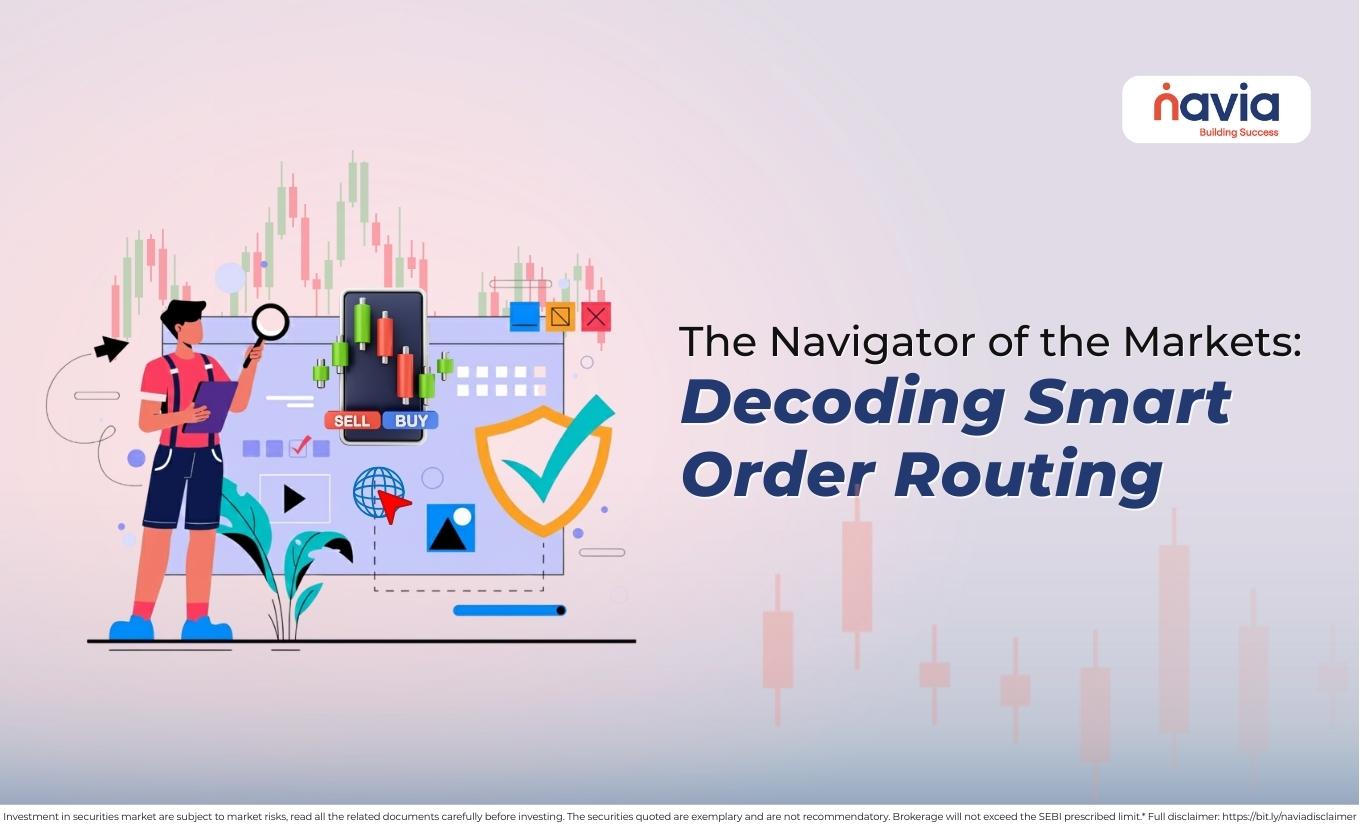Swing Trading vs Day Trading: What’s the Difference?

If you start trading in the stock market, you can learn a variety of strategies that will help you to cater to different risk appetites, goals, and time commitments. The most widely practiced approaches are swing trading and day trading. Both are aiming to achieve profit from short-term market movements, but the methods, time frames and risk profiles differ significantly.
This blog is a guide that will educate you about the nuances of swing trading vs day trading, its benefits, drawbacks and which might suit you best. Let’s delve into the topic!
What is Swing Trading?
Swing trading is like a strategy that allows stocks or financial instruments to hold for several days to a few weeks. The major goal of this method is to yield significant returns within a medium-term period. The traders who use this strategy will rely on technical analysis, chart patterns, and also fundamental analysis to make their movements.
Compared to Day Traders, Swing Traders were not concerned about the minute-by-minute price fluctuations of the market. Instead, they look at broader trends and aim to capitalize on price momentum or breakouts over a span of time.
Benefits of Swing Trading
Lower Transaction Costs
Swing traders are executing fewer trades compared to day traders, and they incur fewer brokerage and transaction fees.
Less Time-Intensive
It is considered the main benefit of swing trading; the traders don’t need to constantly monitor market movements. They can analyze the charts during off-market hours and manage their trades with minimum daily screening time.
Flexible for Working Professionals
Swing trade is suitable for those who want to trade part-time without giving up their full-time job.
Larger Gains Per Trade
Swing traders aim to get larger price movements than day traders, that can result in higher profits per trade.
Beginner-Friendly
If someone is a beginner in trading, they can choose swing trading because it doesn’t need more experience compared to day trading. They have time to learn about the market and make informed decisions slowly.
Drawbacks of Swing Trading
Overnight Risks
Overnight risks such as economic data release, unfavorable news or global events can impact the price before the market opens.
Psychologically Challenging
It is psychologically challenging because the swing traders stick to a strategy and wait for the right setups. So, the traders required patience.
Market Knowledge
If you are a beginner, you must understand the market quickly, otherwise your wrong decisions cause huge losses.
What is Day Trading?
Day trading is also known as Intraday Trading, it means buying and selling financial instruments within the same trading day. Intraday traders will close all positions before the market ends to avoid the overnight risks. Without a strong understanding of market dynamics and real-time analysis, you won’t be able to make quick decisions.
The strategy focused on achieving profits from small price movements requires high trading volume, speed, and precision. Day traders and swing traders operate in different time periods and psychological environments.
Benefits of Day Trading
No Overnight Risk
All traders will close their trading by the end of the day, that will eliminate the uncertainty of night price gaps.
Multiple Opportunities Daily
Day traders can get several trading opportunities within a single day and that leads to multiple income sources.
Instant Feedback
The results are realized the same day, so traders can quickly analyze their performance and adjust their strategies.
Leverage Access
Many brokers offer margin accounts that allow traders to use leverage, increasing their potential gains (also increasing risk).
Flexibility and Self-Employment
If you are an experienced day trader, you can work independently, set your own hours, and trade from anywhere.
Drawbacks of Day Trading
Time Commitment
Day trading needs full attention and quick decision-making abilities, because the trader has limited time to make their movement. That’s why it’s unsuitable for those who have a full-time job.
Psychologic Pressure
The fast-paced nature of daily trading can lead to emotional decision-making and burnout if not managed carefully.
High Transaction Cost
If a trader trades more, automatically the fees and commissions will increase, and the increased transaction cost will impact their overall profitability.

Key Difference between Swing Trading and Day Trading
| Factors | Swing Trading | Day/Intraday Trading |
| Time Frame | Days to weeks | Minutes to hours (within a day) |
| Time Commitment | Few hours a week | Full-time |
| Risk Level | Moderate (overnight risk) | High (Intra-day volatility) |
| Stress Level | Lower | High |
| Nature of decision-making | Few decisions are made over several days | Several decisions made in a single day |
| Market Monitoring | No need of minute-by-minute monitoring | Need constant monitoring during market hours |
| Using Tools | Technical and fundamental analysis | Primarily technical analysis |
| Capital Requirement | High capital for longer holding | Less capital for quick trades |
| Suitable for | Part-time traders | Full-time traders |
Returns From Swing vs Day Trading
If we are talking about the returns of these two strategies, both can be profitable in different ways. Swing trading may yield fewer but larger profits per trade, whereas day trading targets smaller gains more frequently. In the day trading, it can result in substantial income, but it has high risk and emotional strain.
A swing trader vs intraday trader might enjoy more consistent performance over time, especially if they avoid overtrading and allow market patterns to play out. On the other hand, an experienced day trader can only achieve gains faster through their experience, risk management, and fast execution.
Conclusion
The selection between swing trading vs day trading completely depends on your lifestyle, market knowledge, and risk tolerance. If you prefer a balanced approach with less screen time you can choose swing trading and if you want to dive deep into market action and have the time to spend, choose day trading.
Both methods need education and a well-tested strategy. If you are a day or swing trader, your success lies in reading charts and price movements. Whether you’re into quick moves or longer swings, Navia gives you the tools, charts, and insights to trade with confidence.
Do You Find This Interesting?
Is swing trading better than day trading?
Swing trading can be better than day trading for those seeking less stress, fewer trades, and more time for analysis.
What is the 1% rule in swing trading?
The 1% rule in swing trading advises risking no more than 1% of your total trading capital on a single trade to manage risk effectively.
What type of trading is most profitable?
The most profitable type of trading depends on the trader’s skill, strategy, risk tolerance, and market conditions—no single style is universally best.
Is swing trading really profitable?
Yes, swing trading can be profitable with the right strategy, discipline, and risk management.
How much investment is enough for Swing trading?
You can start swing trading with as little as ₹10,000 to ₹50,000 in India but always trade only what you can afford to risk.
What do swing traders do?
Swing traders aim to capture short- to medium-term gains by holding positions for several days to weeks based on market trends and technical analysis.
What does day traders do?
A day trader buys and sells financial instruments within the same day to profit from short-term price movements.
DISCLAIMER: Investments in the securities market are subject to market risks, read all the related documents carefully before investing. The securities quoted are exemplary and are not recommendatory. Brokerage will not exceed the SEBI prescribed limit.






